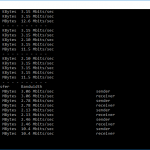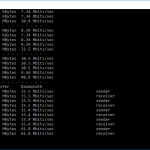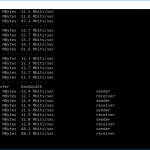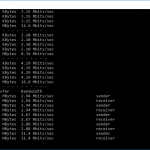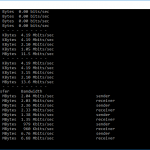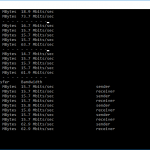We replicated the testing from our Ultimate Mesh WiFi Router Shootout as closely as possible with the NETGEAR Nighthawk X6S Tri-Band WiFi Range Extender. However, we no longer had the Apple Macbook Pro in our possession, so had to leave this set of tests out, and the Acer laptop was replaced with an HP one that has an identical 802.11ac WiFi specification.
We replicated the positions from the Ultimate Mesh WiFi Router Shootout, with eight different locations for our test notebooks. The clients used were an HP Spectre 13 X2 notebook with 2×2 802.11ac WiFi, and an older HP Folio 13 which maxes out at 3×3 802.11n WiFi.
In each case, we used the freely available iPerf 3.1.3 software, which stresses a network by sending packets of random data and measures the throughput. One system acts as a server, and the other as a client, as data is sent between them. In all cases, we used an Armari Windows 10 workstation connected to the primary router via Gigabit Ethernet as the server, so that the WiFi was always the slowest connection.
These are the iPerf commands we used:
For the server: iperf3 –s –i 1
For the client: iperf3 –c <IP Address> –P 4 –i 1 –t 60
Note that the client command sends four streams of data simultaneously, simulating a multi-client connection as closely as possible with just one client. The software takes 60 throughput readings at one second intervals and then averages the result.
The above diagram shows the layout of the house we used for testing. Note that we didn't test on the top floor of the house because this was directly above the first floor and wouldn't have provided much of a range test, or notably different results to the lower floor. Instead, we used two locations on the same floor as the router (the first floor), then more distant locations on the ground floor extending out the back of the house into the garden.
Each test location, numbered in the diagram above, was approximately 5m away from the last one.
With the mesh networking and standalone router products used for comparison, location 1 was very near to the router, around 1m away. The next location – 2 – was around 5m away, with a wall in the way, but on the same floor. Location 3 was on the floor below, so had walls and a floor in between, but was a further 5m away. Location 4 was the last one actually inside the house. Locations 5 to 7 were then 5m further down the garden. Location 8 was only 2m further down, as this was the end of the garden, but also behind a shed, so posed a significant challenge that only a few mesh WiFi systems can cope with.
We should also say a few words about the location of the satellites. The routers or primary unit were always placed in the same location, in the first floor study next to the broadband. In the case of three-unit mesh systems such as BT Whole Home Wi-Fi and the top Velop option, the second and third satellites were placed at S1 and S2.
With the two-unit Google WiFi, the second unit was placed at S1, due to the recommendation of the setup software. However, in the case of the Orbi, it was possible to place the second unit at S2, due to the signal strength from these systems.
For the X6S, we first tested the standalone XR500 router as a baseline, then retested with the X6S at position S1 to see how it improved performance.
802.11ac 5GHz
At close range, the XR500 on its own is faster over 802.11ac than when the X6S is connected. But both are towards the top end of performance. Move out to 5m, however and the X6S is already over 30 per cent faster than just the XR500. At 10m, the extra performance is even more pronounced, with the X6S providing 3.75 times the bandwidth. Its 263Mbits/sec throughput is almost as quick at the Orbi RBK50.
At 15m, although the XR500 has almost dropped off completely, the X6S is still providing 106Mbits/sec, which is behind the best dedicated mesh systems including NETGEAR's Orbis and the ASUS Lyra, but still very commendable. It's also faster than the ASUS AiMesh.
Unfortunately, this drops off quickly at 20m, with the X6S providing a just about usable 10.4Mbits/sec. The ASUS AiMesh was still going strong at this range, as was the ASUS Lyra and NETGEAR Orbis, although many others are falling behind here too.
At 25m and beyond, the X6S has stopped providing a decent bandwidth, although it does maintain a connection up to and including 30m. This is a little disappointing when our ASUS AiMesh test setup could reach 30m with a usable bandwidth, if configured on the optimal 5GHz radio (see our AiMesh review for details).
Raw 802.11ac Results
802.11n 2.4GHz
With 802.11n, both the XR500 and X6S are merely mediocre performers at close range. Surprisingly, at 5m the XR500 is around 2.5 times faster than the X6S, but the X6S takes over at 10m and beyond.
At 15m, the X6S is 2.3 times faster than the XR500 on its own. Although a number of dedicated mesh WiFi systems are faster at this range, it's competing well. However, at 20m, bandwidth has dropped to 11.4Mbits/sec, which a number of mesh systems beat, as well as ASUS's AiMesh.
Nevertheless, at 25m, performance has improved a little to 13.5Mbits/sec, with competitors starting to draw level or behind, although the best mesh systems are still well ahead. Interestingly, the XR500 on its own is still managing 7.83Mbits/sec, so you're only gaining a little from the X6S's WiFi extension.
This isn't the case at 30m, where the X6S is providing 6.76Mbits/sec but the XR500 has dropped away. Only a selection of dedicated mesh systems can achieve this range. The X6S doesn't reach our “behind the shed” 32m range, however, although very few WiFi systems we've tested have.
 KitGuru KitGuru.net – Tech News | Hardware News | Hardware Reviews | IOS | Mobile | Gaming | Graphics Cards
KitGuru KitGuru.net – Tech News | Hardware News | Hardware Reviews | IOS | Mobile | Gaming | Graphics Cards














